June '98 Project: 1989 Nissan 240SX Turbo
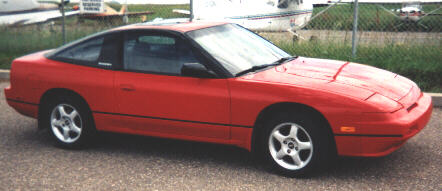

This is an ongoing project car owned by Racetech Inc.
This 240SX was selected to act as a daily driven test bed for SDS products. Straightline performance of the stock vehicle can only be described as inadequate. Vericom testing revealed stunning acceleration with 0-60 taking 9.84 seconds and the 1/4 mile at 17.16@85 mph. This at 3500 feet and 60 degrees F ambient air temp.
The goal of this project was to have lots of low end torque with a super wide power band, good fuel economy, low noise level and factory cruise and A/C operation intact. I wanted a good highway cruising vehicle. Stealth is always important on our cars so there are no flashy graphics, chrome or 5 inch exhaust pipes to give away what lurks underneath. Sheer speed is not the aim of this car but rather quick, reliable performance at under 10 psi boost.
Turbocharging was obviously a must. I drove the vehicle stock for 2 weeks, waiting for all of the bits to arrive. Nissan should be ashamed of the stock driveability that their ECCS delivered. The idle speed control with 3 different control systems was atrocious. Other faults with closed loop being engaged too early in the warmup cycle were also evident. The engine felt very weak below 3500 then not bad to about 5000, then very stiffled above that, probably by the restrictive intake and exhaust systems.
Anyway, the most fun was probably removing all of the factory crap and there is LOTS of it. A multitude of what I call fridgistat valves, hoses, more hoses, extraneous wiring, EGR crap, the ugly airflow meter and the 71 lb exhaust system. I could actually see the engine after this.
Intake
I started with the intake. The stock injectors were removed because they are too small for turbo use at 260cc/min. They were replaced with 360cc injectors by machining aluminum adapters and spacers to adapt to the larger O-ring style. The EGR port was plugged off as were many of the vacuum ports and idle speed control valves. A GM water temp sensor was mounted in the bottom of the water outlet runner. The ridiculous supplementary air valves and actuator were removed also from the intake manifold for better airflow.
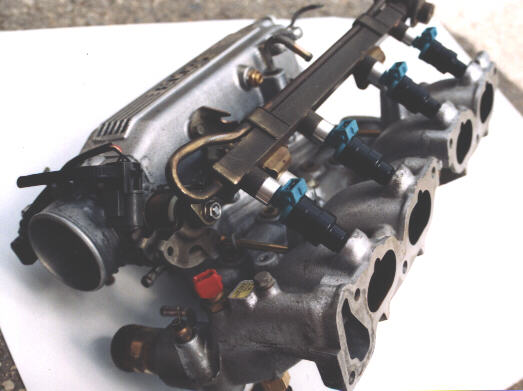
Hall Sensor
The Hall sensor for the F system required a mount to be built off of the timing cover on the lower left. This was machined out of ½ inch T6 plate. The crank pulley was removed and fitted with the 3 magnets required to trigger the F system.
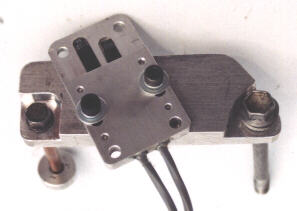
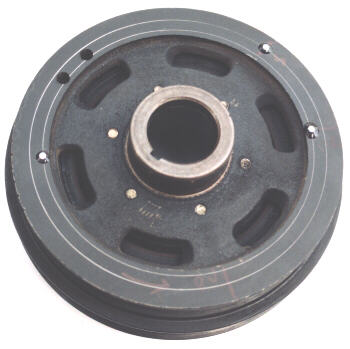
Header
A custom header was fabricated out of schedule 40 weld els in 1.25 inch ID. The turbo flange was angled to allow for easier exhaust outlet plumbing, air filter placement, brake master clearance and A/C hose clearance. Primaries 1 and 4 and 2 and 3 were grouped together for maximum pulse energy and lower backpressure. Everything was then TIG welded.
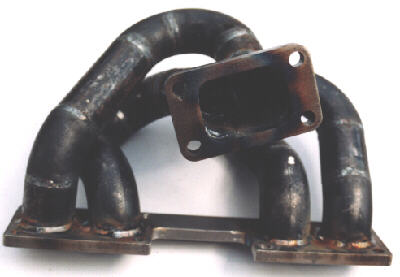
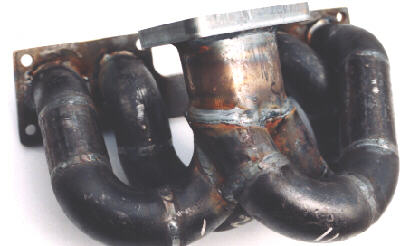
Turbocharger
This was purchased from Turbonetics. It is a T4/T3 hybrid and uses an H-3 compressor with stage 3 turbine wheel in a .63 housing with an integral wastegate and dual port actuator. This was chosen for the most efficient compressor match for low discharge temperatures and low mass on the turbine end with reasonably low backpressure at high boost. Response and flexibility were the aims here. The H-3 also offers decent breathing off boost with a large inlet area.
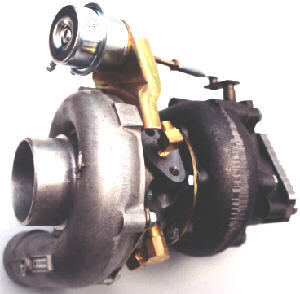
Exhaust system
This was made using 2.5 inch mild steel tubing and mandrel bends. With a T3 turbine, 2.5 inch is all that is required. This made plumbing and ground clearance problems minimal. An Edelbrock stainless RPM muffler was fitted for low noise.
Intercooler
Our standard Spearco core 2-161 was used for low cost and good performance. This is 7.9 x 12.88 x 3.5 inches and fits nicely ahead of the rad. At 250 hp, the pressure drop should be around .8 psi and the efficiency at 60 mph should be in excess of 90%. 2.25 inch mandrel bent tubing is used for plumbing the intercooler.
Engine Management System
I fitted our standard EM-2F, direct fire system to my car. This freed up a lot of space in the left front corner of the engine compartment by eliminating the airflow meter and air filter. This also enabled the distributor to be removed which allows a convenient place for the turbo oil to be drained back without removing the oil pan.
The stock ECU was removed from the right kick panel along with hundreds of feet of stock wiring. The EM-3 was placed in the same spot. The cruise control computer is separate so everything still works there. The A/C control was more difficult. We had to add a special relay to control it.
Boost Control
I fitted our standard DBC to control the integral type actuator.
Wheels and Tires
I installed 15 X 7 ASA wheels and Yokohama A520 205 55 15 tires for some decent grip. These lowered the car a bit and look great. I chose not to lower the car via springs because the car will be winter driven so I need some ground clearance and did not want a bone jarring ride at -30.
Driving It
The engine started immediately and idled well within 5 minutes with slight adjustments.
The car drove quite well with standard settings. About 30 minutes were spent on initial programming out on a deserted stretch of road. Torque at only 3.5 psi was astounding compared to stock. Effortless cruising and hill climbing were demonstrated in 5th gear. This engine tolerates extremely lean mixtures under cruising and low boost operation with AFRs around 18 to 1 at cruise. Fuel economy is about the same as stock - around 28 mpg combined hiway and city. This engine is extremely flexible with boost starting at 2000 rpm and tons of torque available at 3000 and up. Passing exposure in 5th is halved over stock even at low boost. The engine has more torque than stock even from 1500 rpm. It pulls hard to redline and I am just experimenting turning up the boost at this point with the new clutch.
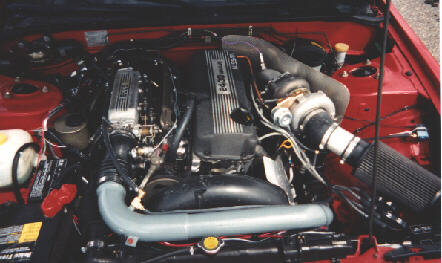
The stock clutch was found to slip in 5th at only 5 psi so an ACT performance unit was fitted. This clutch is stiff but will never slip. The stock rubber driveshaft coupling is annoying with the extra torque available and makes getting the car off the line smoothly a bit difficult even in stock trim. I dislike this aspect of the car the most and it may have to go.
I have spiked the 92 octane pump gas with a gallon of M-85 to reduce the ignition retard under boost and pick up the power. I use this strategy on my turbo Corolla as well with excellent results
Performance Testing with Vericom
With the ACT clutch installed and EM-2 programming mostly complete, I installed the Vericom for some testing. Tests were run at 3600 feet and 73 degrees F with only 7.5 psi boost.
0-60 mph 5.88 seconds
1/4 mile 13.71@107.9 mph
Braking 60-0 118 feet/ 1.21 G peak
Calculated HP 284
These figures are most impressive. Note that this is a bone stock ,12 valve engine internally with about 90,000 miles on it. No porting, no cam. These are 205 street tires and not slicks. The suspension is all factory stock. There is no limited slip. The car is at stock weight with air conditioning, sunroof, power locks and windows intact and note the altitude and boost pressure.
Anyone who discounts the 240 engine as a crude truck motor without performance potential should look at these figures. It is hard to beat cubic inches when it comes to torque. At only 7.5 psi, the stock hp has been DOUBLED. Think of what a fresh, 16 valve would do with porting, cam and 15 psi. Probably 500 + hp.
One of the first victims of the 240 was a 4.6 liter DOHC Mustang which I liquidated at only 3.5 psi. It was no contest at all.
Mileage is pegged at 31-33 mpg (Imperial) on the hiway at speeds from 75-90 mph.
Injector duty cycle reaches 85% which when worked back at a SFC of .55 lbs/hp/hr. Indicates 290 hp which is very close to the Vericom.
240SX Acceleration update
With the boost pressure turned up to 10.2 psi and the Vericom fitted, I made some more 1/4 mile runs. We now have the tachometer working so I was not guessing at shift points as in the first tests, also ignition retard was eliminated completely with 12% methanol added to the gas. Temperature was slightly cooler at 66F and I found a patch of stickier pavement to launch from. In 4 runs, the best ET and speed were 13.06 @ 114.7 mph. Twelves don't seem to be in the cards with these tires. When rolling on the throttle in 2nd, the tires will spin when the boost comes in at about 4500 rpm and launching is very critical. Calculated hp is 332. Injector duty cycle reached 102% so this is the absolute maximum possible with these injectors. Shifts were made at 6500 rpm with the rev limiter set for 6625. I have returned the boost to 7.5 psi for the street to ensure the longevity of the driveshaft coupling and stock pistons.
Update. 10/28/98
Soon after quarter mile testing at 10 psi boost, the engine developed a rough idle and became hard to start. With a lot of fumes coming from the crankcase breathers, it was obvious that some piston ring lands were broken. Compression testing revealed #1 cylinder down to 70 pounds. Disassembly revealed broken lands on #1 piston. A rebuild is under way at present. This engine was never detonated so the damage was somewhat surprising however, the short compression height on this engine means that the ring lands are quite narrow so not so strong. This is the weak point of the engine so I would recommend that you don't exceed about 6 psi if you want to keep things in one piece or that you install stronger pistons.
Project 240SX update.
General impressions of the KA24 engine:
Head
With 2 intake valves and one exhaust actuated by a single overhead cam and rocker arms, this is rather conventional. Valve sizes are adequate. Intake port area is rather small for 600cc cylinders but this certainly helps the torque through high velocities. I am not impressed with the cheesy single link timing chain setup. With the kind of power that the engine produces at low boost, there are no doubts that this head works just fine. Head bolts are too small in my opinion for high boost longevity.
Crank
Typical of older Nissan L series engines, the metallurgy and machining is excellent. This looks like a very strong crank with big journals. Unfortunately, the crank only has 4 counterweights which is total cheese on large 4 cylinder engine. This contributes to the roughness of the engine. The main bearings showed considerable wear on #1 and 2 likely due to loads imposed by accessories. Rod bearings were mint.
Rods
Typical Nissan. Good rods but because of the long stroke, they are long also. I would not routinely run them over 6500 rpm and 300 hp.
Pistons
What can you say. Cast pistons often are not up to the task of double the stock HP as proven again in this case. This engine design can trace its roots back to a 1600cc iteration. It has been stroked and bored to the limit. As a result, compression height is short and the rings are jammed into this small dimension which makes for narrow, weak ring lands. There just is not enough material here. Limit your hp to under 250 with stock pistons. Looks like a custom forged piston could lower the compression about a point and still offer slightly thicker lands by moving the rings down right to the pin. Pin is a little on the small size also.
Block
As mentioned above, there is no more room to make this thing any bigger and there are no over bore pistons available. Bore spacing is scary close so that O-ringing would be iffy. (See pictures) This is not a block design for super high boost pressures. On the plus side, it is fitted with a main cap girdle which unfortunately is held in place with marginal Nissan bolts. Oil pump is the same old pump used for years- big and reliable.
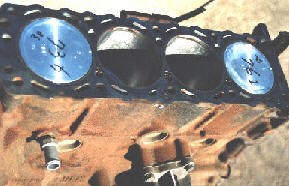 | 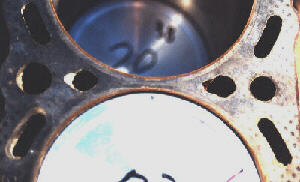 |
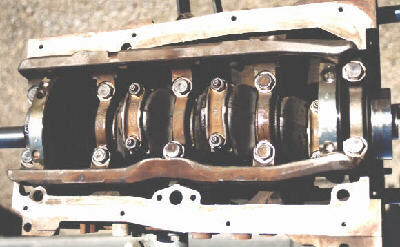 | 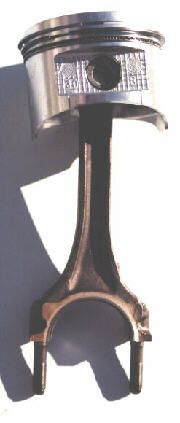 |
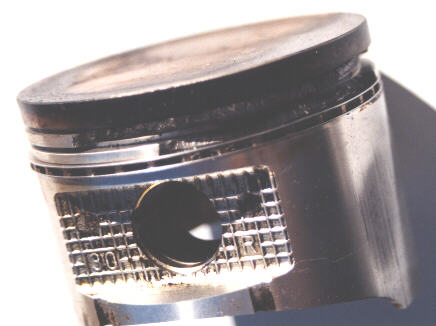
Update 05/17/99
I'm now running 6 psi with about 6% methanol in the fuel. The ignition curve has been revamped to reduce total timing in the torque peak area so that there is no chance of detonation. HP is in the 230 to 250 range. The look of embarrassment on the face of a BMW 540i driver yesterday made this all worthwhile as I obliterated him.
Update 06/05/00
I just installed some 360cc high impedance, Ford Motorsport injectors into the engine, replacing some custom 470cc pieces. The idle had been inconsistent at times and recently a hot start problem had been showing up, indicating a possible leaking injector. At the same time, an EM-3 4F ECU was installed to bring the car up to the latest specs. Right off the bat, idle and starting were improved. I'll be re-tuning the system over the next couple of weeks.
Update 03/19/01
We have installed version 9 software into the car and are experimenting with a water/methanol injection system. The system consists of a BMW washer tank and pump, MAC solenoid valve, Nozzle assembly built from an AN fitting and PT6 jet engine fuel nozzle and custom software to activate the system at 1 psi of boost. The pump puts out 30psi and the nozzles delivers highly atomized fluid at a rate of 180cc/min just prior to the throttle body. We'll update this as data becomes available.

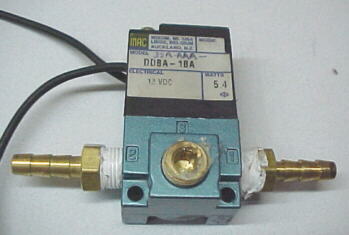
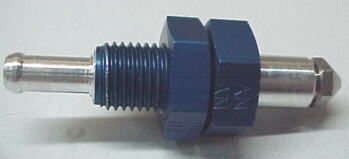
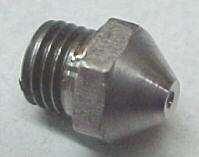
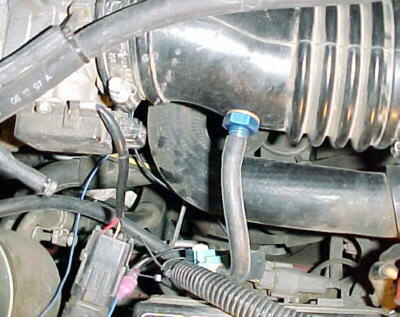
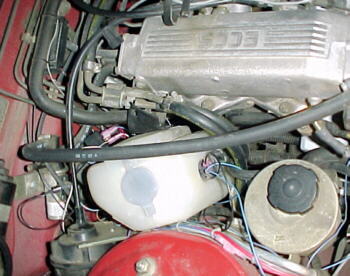
Update 05/02/01
After a few tanks of gas, I've managed to tune the car to run on straight 92 octane fuel at about 5psi without detonation. This will allow me to do longer road trips without lugging around a jerrycan of methanol. I would say that the power is about the same as before- probably around 230-240hp. I could stay with an Acura NSX in a race a couple of days ago. The timing still has to be retarded with the water injection which hurts the power a lot but I am generally happy. The small water tank lasts about 6 tanks of fuel in fairly hard city driving.
Update 08/14/02
The car has now been fitted with the latest V11 software for testing. It continues to run reliably with about 25,000 miles on the turbo engine.
Update 04/25/03
We recently had the car to the road race track for a BMW instructors school. The car proved to be faster than most of the pre- 2000 M cars in a straight line and in the corners. The BMW boys did not say much after the track sessions but the looks on their faces showed that they don't like being passed on the straight too much. A '91 Nissan 300ZXTT with Stillen parts was also no match down the straight or in the corners. The brakes were terrible however, basically being gone in 1 hard lap. This session gave us a chance to race test the new spec 4F coil pack, which performed flawlessly.
Please note:
We get many, many E-mails at Racetech enquiring about turbo kits for the 240SX. We do not make or sell turbo kits at all, only the SDS engine management systems. This was a custom, one-off system for development purposes. Over 300 hours and around $5000US was invested in the project. Be prepared to spend a similar amount of time and money to get similar results. Please don't E-mail us about turbo headers or about doing work on your car.
Racetech Home Page: www.sdsefi.com